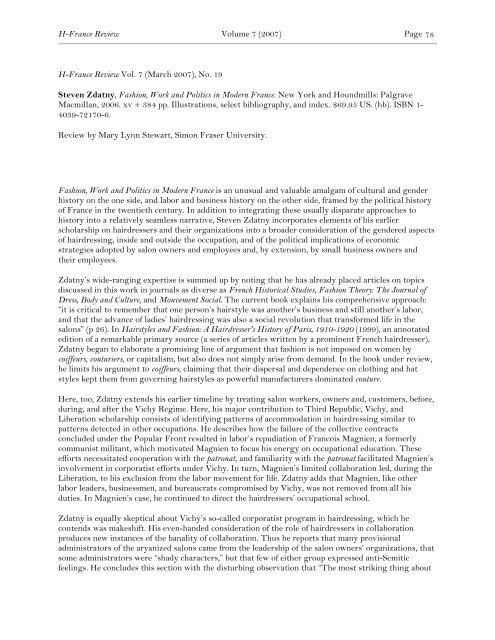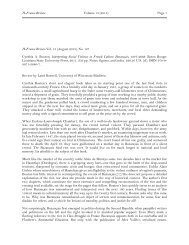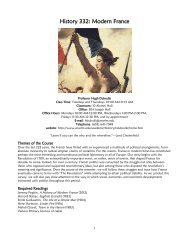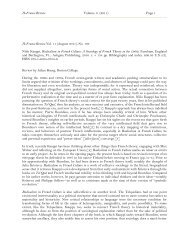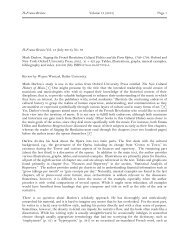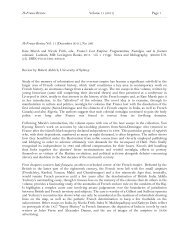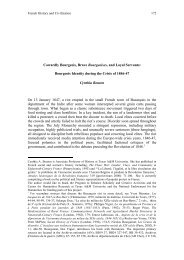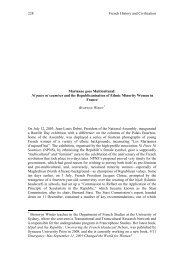Review - H-France
Review - H-France
Review - H-France
You also want an ePaper? Increase the reach of your titles
YUMPU automatically turns print PDFs into web optimized ePapers that Google loves.
H-<strong>France</strong> <strong>Review</strong> Volume 7 (2007) Page 78<br />
H-<strong>France</strong> <strong>Review</strong> Vol. 7 (March 2007), No. 19<br />
Steven Zdatny, Fashion, Work and Politics in Modern <strong>France</strong>. New York and Houndmills: Palgrave<br />
Macmillan, 2006. xv + 384 pp. Illustrations, select bibliography, and index. $69.95 US. (hb). ISBN 1-<br />
4039-72170-6.<br />
<strong>Review</strong> by Mary Lynn Stewart, Simon Fraser University.<br />
Fashion, Work and Politics in Modern <strong>France</strong> is an unusual and valuable amalgam of cultural and gender<br />
history on the one side, and labor and business history on the other side, framed by the political history<br />
of <strong>France</strong> in the twentieth century. In addition to integrating these usually disparate approaches to<br />
history into a relatively seamless narrative, Steven Zdatny incorporates elements of his earlier<br />
scholarship on hairdressers and their organizations into a broader consideration of the gendered aspects<br />
of hairdressing, inside and outside the occupation, and of the political implications of economic<br />
strategies adopted by salon owners and employees and, by extension, by small business owners and<br />
their employees.<br />
Zdatny’s wide-ranging expertise is summed up by noting that he has already placed articles on topics<br />
discussed in this work in journals as diverse as French Historical Studies, Fashion Theory: The Journal of<br />
Dress, Body and Culture, and Mouvement Social. The current book explains his comprehensive approach:<br />
“it is critical to remember that one person’s hairstyle was another’s business and still another’s labor,<br />
and that the advance of ladies’ hairdressing was also a social revolution that transformed life in the<br />
salons” (p 26). In Hairstyles and Fashion: A Hairdresser's History of Paris, 1910-1920 (1999), an annotated<br />
edition of a remarkable primary source (a series of articles written by a prominent French hairdresser),<br />
Zdatny began to elaborate a promising line of argument that fashion is not imposed on women by<br />
coiffeurs, couturiers, or capitalism, but also does not simply arise from demand. In the book under review,<br />
he limits his argument to coiffeurs, claiming that their dispersal and dependence on clothing and hat<br />
styles kept them from governing hairstyles as powerful manufacturers dominated couture.<br />
Here, too, Zdatny extends his earlier timeline by treating salon workers, owners and, customers, before,<br />
during, and after the Vichy Regime. Here, his major contribution to Third Republic, Vichy, and<br />
Liberation scholarship consists of identifying patterns of accommodation in hairdressing similar to<br />
patterns detected in other occupations. He describes how the failure of the collective contracts<br />
concluded under the Popular Front resulted in labor’s repudiation of Francois Magnien, a formerly<br />
communist militant, which motivated Magnien to focus his energy on occupational education. These<br />
efforts necessitated cooperation with the patronat, and familiarity with the patronat facilitated Magnien’s<br />
involvement in corporatist efforts under Vichy. In turn, Magnien’s limited collaboration led, during the<br />
Liberation, to his exclusion from the labor movement for life. Zdatny adds that Magnien, like other<br />
labor leaders, businessmen, and bureaucrats compromised by Vichy, was not removed from all his<br />
duties. In Magnien’s case, he continued to direct the hairdressers’ occupational school.<br />
Zdatny is equally skeptical about Vichy’s so-called corporatist program in hairdressing, which he<br />
contends was makeshift. His even-handed consideration of the role of hairdressers in collaboration<br />
produces new instances of the banality of collaboration. Thus he reports that many provisional<br />
administrators of the aryanized salons came from the leadership of the salon owners’ organizations, that<br />
some administrators were “shady characters,” but that few of either group expressed anti-Semitic<br />
feelings. He concludes this section with the disturbing observation that “The most striking thing about
H-<strong>France</strong> <strong>Review</strong> Volume 7 (2007) Page 79<br />
the dossiers of the administrateurs provisoires and biens aryanisés is not the gross mistreatment they<br />
describe. Rather, it is the tone of bureaucratic normality pervading the documents” (p. 188).<br />
The comprehensive approach operates in the particular sections as well as in the overall narrative. His<br />
cultural history meshes material and popular culture. In the opening chapter on hairdressing before the<br />
First World War, this reader (who fancies herself a women’s historian and a fashion historian) learned<br />
that the massive hairstyles of nineteenth-century ladies required many hairpieces made from human hair<br />
purchased from a world market in “raw hair” centered, in <strong>France</strong>, at the Limoges Bourse aux Cheveux.<br />
Heads full of curls on grandes dames or grandes horizontales required daily professional upkeep in their<br />
homes, not in salons. The trend toward smaller, simpler hairstyles in the early twentieth century takes<br />
on a whole new meaning in light of the time and effort involved in those earlier hairstyles.<br />
Of course, Zdatny addresses the “hot” topics of modernity and the modern woman. The discussion of<br />
modernity in hairdressing is brief, revealing that there was a battle between the classicists (elaborate<br />
styles) and the modernists (simpler styles) among hairdressers. An entire chapter is devoted to “The<br />
Bob,” the short haircut that aroused so much controversy in the 1920s. After due attention to the<br />
cultural commotion over the bob as a sign of sexual confusion, Zdatny identifies how hairdressers and<br />
their customers softened and thereby feminized their new cuts by applying permanent waves. From the<br />
owners’ point of view, this had several advantages: more women than ever before went to the salons,<br />
where they paid three hundred or more francs for perms. More generally, as Zdatny states, “The<br />
significance of the bob thus lay not in a particular length or shape of hair, but in the collapse of the old<br />
social frontiers of fashion” (p. 71).<br />
Another methodological mix in Fashion, Work and Politics is labor and gender approaches. In the late<br />
nineteenth century, we learn, hairdressing was ninety percent male, with men serving both as barbers<br />
for men and as hairdressers for women. At that time it was among the poorest trades, in terms of<br />
overcrowding, wages (lower than those of the average male laborer), and working conditions. Aside<br />
from working eighty to ninety hours per week and more than 300 days a year, hairdressers suffered<br />
from a variety of occupational illnesses like eczema, asthma, varicose veins, and tuberculosis as new<br />
technologies brought new toxins into the small and usually poorly ventilated salons. During and after<br />
the First World War, when the trade lost almost ten percent of its workforce, women moved into the<br />
salons as workers and as owners. Entering the occupation in a time of war and simplified hairstyles,<br />
many women did not get any training in the previously lucrative skills of making postiches (the main<br />
type of hairpiece for women). Although Zdatny does not make the point, this pattern of entry into less<br />
skilled work paralleled developments in retail clerking and office work. However, he notes that the<br />
continuing influx of women coincided, not with decline, as many labor historians argue, but rather with<br />
prosperity, at least until the depression.<br />
The chapters on organization of the employers and workers read like the more traditional labor<br />
histories, listing unions, federations, splits between federations, and strikes, enlivened by identifying and<br />
following the trajectory of a few union leaders. The largely male unionized workers engaged in many<br />
strikes to get the forty hour week and English weekend, though they at best obtained fifty-two to fiftyseven<br />
hour weeks (the difference reflecting Paris versus the provinces). Zdatny recognizes that “A twoday<br />
strike involving fifty barber assistants…. probably does not rise to the level of national drama. Yet<br />
it has something important to teach us about working life and social reform in the early Third Republic”<br />
(p. 50).<br />
Ultimately, probably the most positive feature of Fashion, Work and Politics in Modern <strong>France</strong> is linking<br />
the apparently frivolous topic of hairdressing with undeniably serious developments in economic and<br />
political history. For instance, Zdatny connects the growing practice of wet- (as opposed to dry-)<br />
washing women’s hair with provision of municipal and household utilities, such as a public water supply<br />
and hot running water, as well as the development and marketing of shampoos. Similarly, he links
H-<strong>France</strong> <strong>Review</strong> Volume 7 (2007) Page 80<br />
dangers to customers of hair salons, such as burns from noxious chemicals used in hair dying, to<br />
industrial health and safety issues such as respiratory disorders and occupational rashes among<br />
hairdressers.<br />
Mary Lynn Stewart Simon Fraser University mstewart@sfu.ca<br />
Copyright © 2007 by the Society for French Historical Studies, all rights reserved. The Society for<br />
French Historical Studies permits the electronic distribution for nonprofit educational purposes,<br />
provided that full and accurate credit is given to the author, the date of publication, and its location on<br />
the H-<strong>France</strong> website. No republication or distribution by print media will be permitted without<br />
permission. For any other proposed uses, contact the Editor-in-Chief of H-<strong>France</strong>.<br />
H-<strong>France</strong> <strong>Review</strong> Vol. 7 (March 2007), No. 19<br />
ISSN 1553-9172


